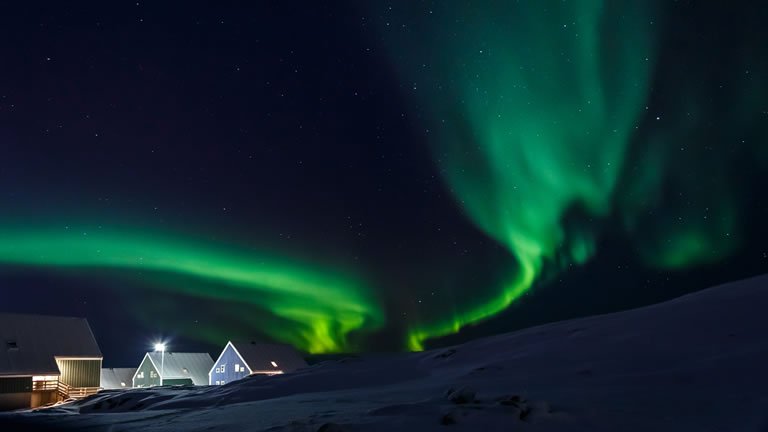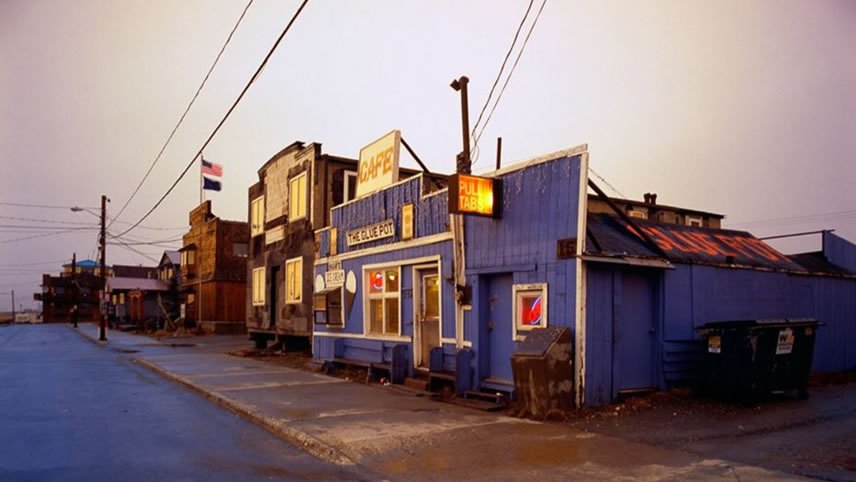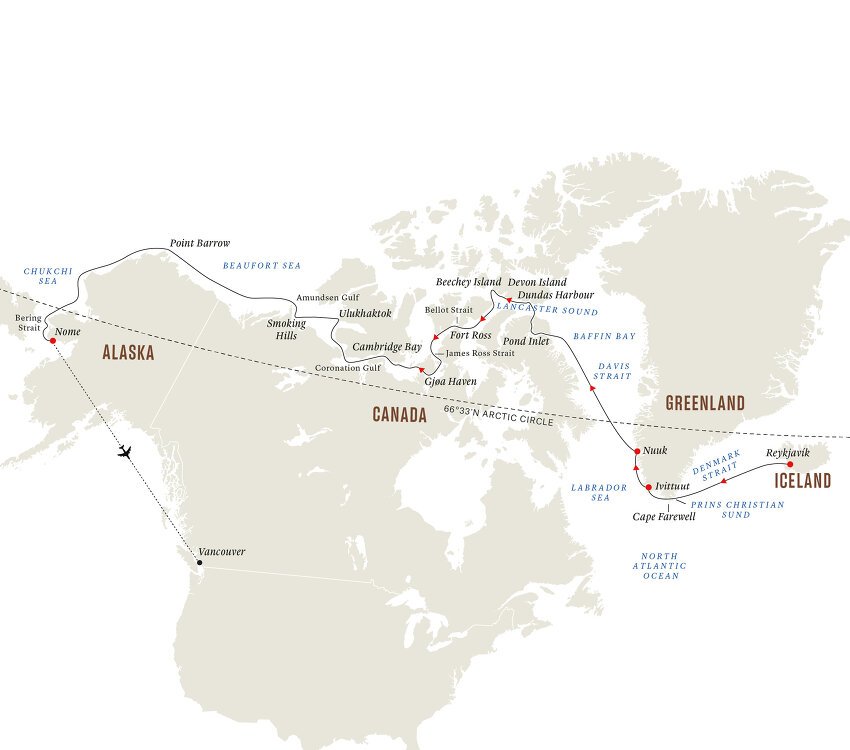Overview
Itinerary
Your adventure starts in Reykjavik, the northernmost capital in the world. Reykjavik is simultaneously quaint and cosmopolitan. This small city is the perfect size for a walking tour, packed full of art, culture and history.
Take a stroll along Laugavegur, the main shopping street, with its boutiques and outdoor shops. You might like to pick up some Icelandic knitwear, famous for its quality, style, and warmth. You can also head towards the architecturally striking Hallgrimskirkja Cathedral. Art lovers can visit the Reykjavik Art Museum, National Gallery and the many smaller galleries and museums dotting the city.
Stopping off at the National Museum, the Saga Museum and the Maritime Museum is sure to fill you in about Iceland’s history. And bring your swimsuit if you fancy a dip in one of the city’s 18 swimming pools, many with saunas and hot tubs.
At Reykjavik’s harbour, MS Fritdjof Nansen awaits you. After you collect your complimentary expedition jacket and check-in, you’ll have time to settle in your cabin. There is a mandatory safety drill just before departure after which you can walk around to explore the ship.
The welcome dinner in the evening ends with a toast by the Captain wishing everyone an enjoyable expedition. You’ll then meet the Expedition Team and key members of the crew who’ll take you through an important health and safety briefing.
Pre-Programme
Why not book a two-day or four-day Pre-Programme with us to spend some extra time discovering Iceland’s nearby Golden Circle. From Reykjavik, whose name means ‘Smokey Bay’ due to the rising steam from the surrounding geothermal features, you’ll be just hours away from geysers, glaciers, hot springs and waterfalls.
Ease into your adventure as you spend today at sea on the way to the Northwest Passage. The Denmark Strait is actually the site of the world’s largest waterfall... underwater! The mixture of warm and cold currents, plus strong winds means that the waters are sometimes a bit choppy.
Aboard the ship, you’ll have time to relax, get to know your fellow travellers, and check out the onboard facilities. In the Science Center, the Expedition Team will hold lecture programmes on the wildlife and ecosystems of the Arctic, preparing you for the adventure ahead.
They’ll also talk through important guidelines from AECO, the Association of Arctic Expedition Cruise Operators. You'll learn how you can protect wildlife habitats, keep a safe distance from animals, and visit Arctic communities in a dignified and respectful way.
If you feel like getting active, you can hit the gym and get your pulse up. You’ll also have access to a sauna, an infinity pool, and two outdoor hot tubs. Drinks can be enjoyed in the panoramic Explorer Lounge & Bar too, while settling into a sofa and watching the rhythmic ocean waves roll by outside.
Get ready to marvel at some of the most stunning views on the planet in the Prince Christian Sound region. This southern Greenland sound connects the Labrador Sea and the Irminger Sea, separating the mainland from Cape Farewell archipelago.
The 60-mile waterway is surrounded by granite mountains with sharp peaks, some reaching up to 7,200 ft. You’ll marvel at the maze of geological patterns in the rock face, from deep cracks and crevasses to lines of black lichen that seem to seep from the stone like paint.
The muted greys and rusted greens of the mountains stand in contrast to the bright white of the many glaciers you’ll see. These slow-moving masses of ice grind their way from the enormous Greenlandic Ice Sheet and flow straight into the sound, calving white-blue icebergs of all sizes, shades, and shapes. You’ll understand why 15th century Italian explorer John Cabot famously described Prince Christian Sound as ‘a river of melted ice’.
Get your camera ready and join the Expedition Team on the observation deck. There are only two signs of human life here: the Danish weather station built by the US during the Cold War at the entrance to the fjord, and the colourful houses of the 100-strong fishing and hunting village of Aappilattoq, which when translated from local Greenlandic Inuit means ‘Sea Anemone’.
You may see ringed seals and bearded seals on the ice, while the likes of Glaucous Gulls and Black Guillemots nest in the steep cliffs. Minke and humpback whales may make an appearance too, although they tend not to swim into the narrow stretches of the sound, preferring the wider sections at the entrance.
Navigating Prince Christian Sound is only possible in summer each year when sea ice is less packed and icebergs don’t block the entrance. However, weather, sea ice, and gate-keeping icebergs on the day may mean our route is still barred.
If that does happen, don’t worry! It’s all to be expected on an expedition into true wilderness. This is where nature sets the rules, not the other way around. We may instead sail towards Nunap Isua, otherwise known as Cape Farewell, the southernmost point of Greenland.
Do you like to visit ghost towns? Ivittuut is exactly that – a mining outpost of long-forgotten spectres, some old and some even older. This was once a busy cryolite mining station, but nowadays the only inhabitants you might see are wandering muskoxen grazing the overgrown grass around the abandoned buildings.
Amazing at is sounds, Ivittuut once played a key role in history, arguably allowing the Allies to win the Second World War. At the time it was the largest cryolite mine in the world – cryolite being a naturally occurring rare mineral used in the production of aluminium alloys – and when Denmark was invaded, the US secretly stationed 500 troops here to prevent the supplies falling into German hands.
This strategy prevented the German forces from using the rare cryolite to manufacture their fighter planes, giving the Allies the upper hand at a pivotal point in the war. Instead, the cryolite was shipped to the UK and used to manufacture aircraft that fought in the Battle of Britain. If it were not for this move, the outcome of the war could have been very different.
Rewinding history further to a time long before the miners arrived, Norsemen settled in this area more than a thousand years ago. Alas, no trace of them remains. Ivittuut is believed to have been the last Viking settlement in Greenland, but was also the first to be abandoned, for reasons that can only be speculated upon.
It’s an unforgettable experience visiting Ivittuut, and the abandoned buildings and lonely cemetery contrast starkly with the surrounding natural beauty. Wander around these eerie yet photogenic ruins today and you’ll see decaying structures and scattered, rusting machinery. It’s difficult to imagine how crucial this small outpost was at a key point in our history.
Nuuk was settled in 1728, which makes it the oldest settlement in the nation. And although Greenland’s capital is classed as a city, fewer than 17,000 people call it home. The name Nuuk means peninsula, and it’s located at the mouth of a system of spectacular fjords and mountains.
The first thing you’ll notice about this low-rise settlement is how colourful the houses are, with red, green, blue and yellow buildings standing out against the icy black and white backdrop of the mountains.
Today Nuuk is a place where old and new traditions meet, from the picturesque old buildings dotting the edge of the fjord, to the ultra-modern architecture of the Greenlandic Parliament and the wave-shaped Katuaq Cultural Centre inspired by the Northern Lights.
You can visit the oldest building in Greenland at Hans Egede’s House, constructed in 1721, by the Norwegian missionary who is credited as founding the city. Elsewhere in the city, you can look for a statue and a church named after him.
The red-painted Nuuk Cathedral with the typical Lutheran clock tower and steeple is worth a visit too. Drop by the Greenland National Museum to see the Qilakitsoq mummies or admire local paintings at the Nuuk Art Museum, the only private arts and crafts museum in Greenland.
We’ll also be offering a long hike through Paradise Valley and around Mt. Lille Malene as part of an optional excursion. As you follow a path formed by old reindeer tracks, you’ll bask in splendid views of the Greenlandic coast and pass by a small lake and natural springs.
There are also a range of eateries in Nuuk to satisfy all tastes, some of them featuring local delicacies such as musk ox, seal soup and snow crab on the menus. If you’d rather just have a coffee, there are several excellent cafes that serve hot drinks and snacks such as burgers and Danish pastries.
Named for English explorer John Davis, who led expeditions here searching for a route through the Northwest Passage between 1585 and 1587. Davis was the first to draw attention to seal hunting and whaling possibilities in the area, and to show that the Newfoundland cod fisheries extended this far north.
We have left Greenland behind and now set course for Canada. While sailing across the Labrador Sea, you can continue to enjoy informative presentations by the Expedition Team. Some of their topics could include wildlife you might see in Northern Labrador, Inuit culture, expedition photography, and historic explorers of the Canadian Arctic.
We also support a number of Citizen Science projects that you can join. These projects include Happywhale, where your photographs help identify and track the movement of specific whales across the planet due to their distinguishing characteristics.
Or you can participate in the GLOBE Observer project, which combines your observations of clouds and sky conditions from below with data collected by satellites from above. By participating in these projects, not only will you be supporting the scientific community, you’ll also be gaining a better understanding of the world around you.
It’s now time for us to attempt to make a complete transit of the Northwest Passage. Since the 15th century, there have been fewer than a hundred successful attempts at sailing through the Passage.
James Cook famously attempted it in 1776 and many are familiar with the ill-fated Franklin expedition of 1845. The first to conquer the Northwest Passage by ship was Norwegian explorer Roald Amundsen on an expedition that lasted from 1903 to 1906.
Now, in the modern era aboard our state-of-the-art expedition ship MS Fridtjof Nansen, we’ll enter the Northwest Passage on our own adventure, aiming to sail through to Alaska.
During our journey, we will land at sites that are linked to early exploration history, visit Inuit communities, and hope to spot Arctic wildlife such as polar bears, whales, seals, and a mixture of seabirds.
There will also be opportunities for expedition boat cruising between ice floes, and in true expedition style we’ll go ashore and experience the pristine wilderness first hand.
The ship’s Captain and Expedition Leader will continuously assess the current weather and sea conditions, adapt activities accordingly, and adjust the itinerary to where the sea ice allows us to go. Like all good explorers, we respect and work with nature, not against it.
Here are some of the places in the region that we hope to explore together during landings and short walks, if wind, waves, and sea ice allow:
Pond Inlet
Called 'Mittimatalik' in Inuktitut, it means ‘the place where the landing place is’. This is a traditional Inuit community on Baffin Island, boasting views of Eclipse Sound and the mountains of Bylot Island. It is also known as a great place to see narwhal – the unicorn of the sea.
Devon Island
Welcome to the largest uninhabited island on Earth. The only signs of human life are found at the long-abandoned settlement of Dundas Harbour along with several archaeological sites from the Thule period.
Beechey Island
This is the final resting place for three members of the lost Franklin expedition which sailed into the Northwest Passage in 1845 but never returned. It is customary for explorers in the region to stop and pay their respects at the graves, as Roald Amundsen did in 1903.
Fort Ross
An abandoned Hudson’s Bay Trading post located at the southern end of Somerset Island. The storehouse here is still used as a shelter by occasional travellers, with bunk beds and shelves of canned goods.
Gjoa Haven
Norwegian explorer Roald Amundsen wintered at this hamlet in 1903 on the expedition the ‘haven’ is named after. During his time here, he learnt crucial survival skills from the local Nesilik Inuit. This knowledge would later give him the upper hand in his famous race to the South Pole in 1911. There is an informative walking tour, Heritage Centre, and Hamlet Centre dedicated to the history and culture of the area.
Cambridge Bay
Located on Victoria Island, this is the largest stop for vessels traversing the Northwest Passage. It is also called ‘Iqaluktuuttiaq', or ‘A Good Fishing Place’ due to the Ekalluk River which attracts Arctic char, muskoxen, and caribou.
Ulukhaktok
Many in the 500-strong community are involved in the local artists’ co-op, producing prints, tapestries, and other crafts. This is also the location of the world's northernmost golf course, which plays host to a tournament each summer.
Smoking Hills
We’ll continue into the Amundsen Gulf, where we hope to observe the remarkable Smoking Hills – an amazing sight, with smoke billowing from the cliffs on the east coast of Cape Bathurst. Lignite – a combination of eroded shale and pyrite – spontaneously ignites when exposed to air, creating this photogenic phenomenon.
These final days at sea give you all the time you need to unwind and reflect on your adventure through the Northwest Passage. While away a few hours by the infinity pool, soaking in a hot tub, or relaxing in the sauna. There’s also the indoor gym and outdoor running track where you can keep fit and active.
The Expedition Team will continue their informative lecture programme in the Science Center. Topics, ranging from wildlife, tectonic activity, glaciology, or local history and culture, are designed to help you appreciate the areas you’re sailing through and inform about your upcoming landings.
Crossing the Beaufort Sea, keep an eye on the waters here for bowhead and grey whales. We reach Point Barrow, the northernmost point of the USA and enter the Chukchi Sea. Through the Bergin Strait, you’ll have Russia to the west and the USA to the east. This is the international date line, where you’ll have ‘tomorrow’ on your right and ‘today’ on your left.
We’ll sail through the Bering Strait and look to the skies to spot a range of sea birds. There are over 30 species to see, including Black-legged Kittiwakes and various species of Auklets and Murrelets. Late summer still sees many winged wonders in the region, giving you plenty to point your binoculars at.
Situated on the Seward Peninsula, Nome’s name went down in Alaskan history the day the ‘Three Lucky Swedes’ discovered gold at Anvil Creek in 1898. Prospectors soon flocked in from the Yukon and San Francisco in steamers.
Even the famous sheriff Wyatt Earp followed the call of gold and opened a saloon here. You can see evidence of the gold rush era everywhere, including abandoned dredges, turn-of-the-century steam engines, and old railroad tracks. Cries of ‘Gold! Gold!’ can still be heard today by those prospecting on the banks of the Snake River and elsewhere in the area.
The town also marked the end point of three of Roald Amundsen’s great expeditions: the Northwest Passage in 1906, the Northeast Passage in 1921, and an aircraft attempt to the North Pole in 1926. It seems only fitting that our expedition through the Northwest Passage will also come to an end here.
After disembarking, you’ll fly from Nome to Vancouver and spend the night in a centrally-located hotel.
Your adventure ends in Vancouver. Set amidst beautiful mountain scenery and the waters of English Bay, Vancouver is both bustling seaport and cosmopolitan city.
Its various neighbourhoods buzz with world-class, farm-to-table, fresh cuisine. Chinatown and Punjabi Market have arguably the best Asian food in North America while Commercial Drive is where you’ll find Little Italy.
Also check out Vancouver’s oldest neighbourhood. Gastown’s Victorian buildings house some of the city’s hottest restaurants, and its 547 ft. high Vancouver Lookout offers incredible views.
You can take in the neon lights and nightlife along the Granville Street strip or just go and chill on one of the beaches in West End. The latter is also the gateway to explore the wide-open spaces and greenery of Stanley Park.
Post-Programme
A great way to experience some of Vancouver’s highlights is on our optional Vancouver Excursion as a Post-Programme. Enjoy a full day in Whistler, one of Canada`s most famed ski resorts, including a stop at British Columbia’s highest waterfall, Shannon Falls, to enjoy a ride on the Sky Gondola.
Life Onboard MS Fridtjof Nansen
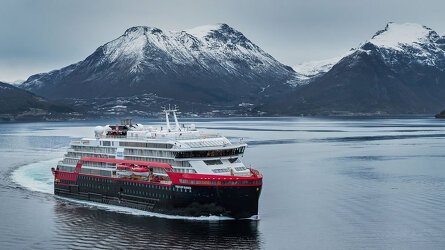
Step aboard this hybrid-powered expedition ship to explore remote corners of the globe in complete comfort. Read more

Your dedicated team deliver an educational onboard program and exciting shore excursions to enrich your expedition. Read more
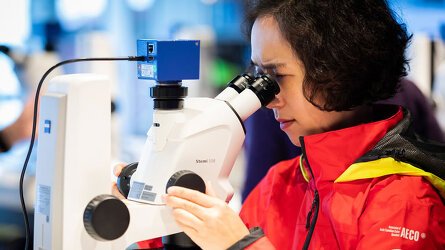
Step into the Expedition Team's headquarters and enjoy specialist lectures and interactive workshops. Read more

Dine on international dishes and menus inspired by Hurtigruten's Norwegian heritage in the three onboard restaurants. Read more
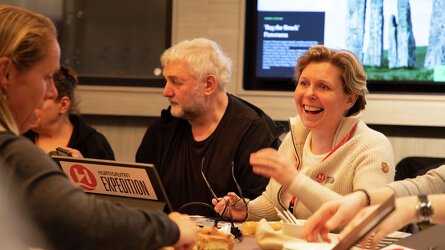
Feel right at home with a sense of comfort and contentment as Hurtigruten share with you the sentiment of 'hygge'. Read more
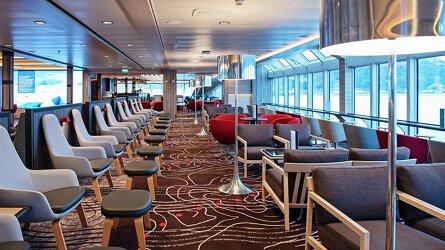
MS Fridtjof Nansen takes the scenic route, and is equipped with viewing spaces to enjoy the views in any weather. Read more

Availability Click on prices below to view cabin upgrades and details
Tour & cruises prices are per person. Prices shown have savings applied, are subject to availability and may be withdrawn at any time without notice. Prices and trip information are correct at the time at this point in time, however are subject to confirmation at the time of booking and are subject to change by Hurtigruten. For cruise itineraries, cabin images are sourced from Hurtigruten. These should be treated as indicative only. Cabin inclusions, upholsteries and room layout may differ to the image(s) shown depending on the ship selected and your sailing dates.
Similar Cruises
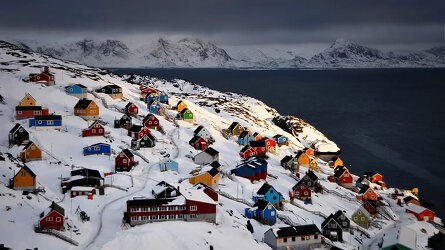
26 Days Reykjavik Seattle
Operated By: Hurtigruten

26 Days Seattle Reykjavik
Operated By: Hurtigruten
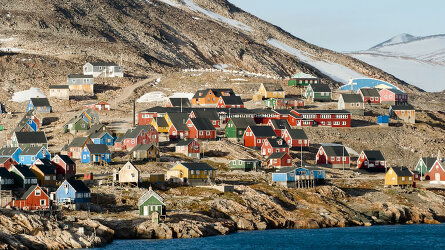
31 Days Reykjavik Montreal
Operated By: Hurtigruten
